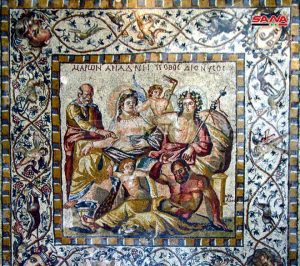As-Suwayda-Sana
The Archaeological Museum of Shahba in Suwayda, located about 90 kilometers south of Damascus, contains mosaic paintings of great beauty and accuracy that tell the ancient Greek myths presented by the Romans in the middle of the third century AD.
The paintings that decorate the museum's floor reflect, according to the head of the Department of the Suwayda Archeology, Dr. Nishwan Kiwan, Greek myths that were represented on stage, most of which spread during the reign of Emperor Philip the Arab, who wanted to make meteors a city competing with the greatest Roman cities, especially Rome.
According to Kiwan, the paintings aim to stabilize the virtues in man and call for the reform of the human soul such as the painting of Aphrodite and Aris, which shows that beauty turns into an "epidemic" if its owner has lost virtue, wisdom and justice.
Kiwan points out that in 1963 four paintings were discovered near the ancient archaeological baths within a Roman basalt circuit built in its current location and kept intact in its colors in addition to two paintings transferred from one of the houses adjacent to the museum.
The first panel represents, as Kiwan mentions the goddess of the sea, “Tets”, which is “The Mermaid of Poseidon”, the sea god of the Greeks, and adorns her hair with sea fish to indicate his bounties. There is also a scary legendary marine animal that wraps on its neck called “Dracon” with a dog's head and symbolizes the depths of the seas to highlight its dangers while Seen on its frame are 9 young angels called "Cupid", riding boats and dolphins, and marching across the sea by order of "Tets", as well as we see the general public riding ships in reference to the use of the sea for transport and travel.
In the second painting, according to Kiwan, the Greek singer, musician and poet Orpheus stands out on a rock playing tunes and singing songs, and animals appear in harmony with his tunes. Spiders stop weaving their homes and bees from reaping honey, as rivers stop flowing and the sea waves subside.
The third panel presents the weddings of Denizius, the fertile god, and we are the gods of the plant, and between them there is a small god of love with a hand holding a torch to show that marriage is not completed only with love, but the one who performs the procedures of the marriage between them is an old man to the left of the plate to indicate that the marriage takes place only by witnesses as it appears at the bottom of the plate. Hercules ”, who represents strength and leans on the ground, rejoicing at the marriage of his friend, Dienius, while the four corners are facing human faces symbolizing the seasons of the year and the continuation of life and fertility throughout its days.
Kiwan notes that the fourth panel represents the love between "Aphrodite", the goddess of beauty, and "Aris", the god of war, who is seen carrying a spear and a gear with a robe on his shoulder, a disgrace, and behind him a woman decorated with a cloak symbolizing chastity, while we find behind "Aphrodite" who looks almost naked young her name " Kharis “with a wreath in her hand to crown the gods. In the upper right corner of the painting a woman named“ Scooby ”leans on a rock and watches the scene from afar as the painting presents two small angels dancing and others carrying a sword.
On the corners of the fifth panel, four human faces representing the four seasons are shown on the corners of the fifth panel. Between each of the two chapters to the right of the plaque is a picture of a woman holding a cup of wine in her hand on the left side.
As for the sixth and final painting, it was transferred to the Sweida Museum, according to Kiwan, and Artemis represents the hunting gods of the Greeks.
The Shahba Museum was opened in 1968 and includes in addition to the paintings a number of basalt pieces, statues, and pottery jars dating back to the Roman era and carved the head of Philip the Arab from the white limestone "Alabaster".
Long life
Photography: Ismail Zain Al-Din
Follow the latest news on the Telegram application on smartphones via the link:
https://telegram.me/SyrianArabNewsAgency
Follow our page on the (VK) social networking site:
http://vk.com/syrianarabnewsagency

